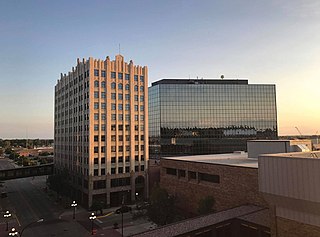
Sioux City is a city in Woodbury and Plymouth counties in the northwestern part of the U.S. state of Iowa. The population was 82,684 in the 2010 census, which makes it the fourth-largest city in Iowa. The bulk of the city is in Woodbury County, of which it is the county seat, though a small portion is in Plymouth County. Sioux City is located at the navigational head of the Missouri River. The city is home to several cultural points of interest including the Sioux City Public Museum, Sioux City Art Center and Sergeant Floyd Monument, which is a National Historic Landmark. The city is also home to Chris Larsen Park, commonly referred to as "the Riverfront", which includes the Anderson Dance Pavilion, Sergeant Floyd Riverboat Museum and Lewis and Clark Interpretive Center. Sioux City is the primary city of the five-county Sioux City, IA–NE–SD Metropolitan Statistical Area (MSA), with a population of 168,825 in 2010 and a slight increase to an estimated 169,405 in 2018. The Sioux City–Vermillion, IA–NE–SD Combined Statistical Area had a population of 182,675 as of 2010 but had decreased to an estimated population of 178,448 as of 2018.

The Mathias Ham House is a 19th-century house in Dubuque, Iowa that is on the National Register of Historic Places. It is located at the intersection of Shiras and Lincoln Avenues, near the entrances to Eagle Point Park and Riverview Park.
Jim Baker (1818–1898) was a frontiersman, trapper, hunter, fur trader, explorer, army scout, interpreter, soldier, territorial militia officer, rancher, mine owner, toll keeper and mountain man. He was a friend of Jim Bridger and Kit Carson and one of General John C. Fremont's favorite scouts.
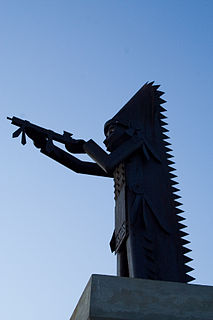
War Eagle was born in Minnesota or Wisconsin around 1785. He had left his own tribe, the Santee, to avoid bloodshed in a fight as to who would be chief.
Iowa is in the tallgrass prairie of the North American Great Plains, historically inhabited by speakers of Siouan languages. The area of Sioux City, Iowa was inhabited by Yankton Sioux when it was first reached by Spanish and French furtrappers in the 18th century. In 1803, during the presidency of Thomas Jefferson, France sold a vast portion of central North America to the United States of America. This "Louisiana Purchase" was largely unexplored. Jefferson sent out the Corps of Discovery, under Lewis and Clark, to scientifically document the territory. In 1804 the Lewis and Clark expedition traveled up the Missouri and set-up camp near what would become Sioux City, Iowa. On August 20, a member of the expedition, Sgt. Charles Floyd died of "bilous colic" and was buried on a bluff overlooking the river. At the time of Lewis and Clark, the Omaha tribe of Native Americans were present just downstream from this region, and the Yankton Sioux were upstream. William Thompson established a trading post near Floyd's Bluff in 1848, and had early ambitions for founding a city. However, Thompson's hopes were never realized; settlers further upriver, between the Floyd and Big Sioux rivers, met with more success.

Theophile Bruguier was a French-Canadian fur trader with the American Fur Company. Bruguier is credited as being the first white settler of what would become Sioux City, Iowa.

The McClellan Heights Historic District is a 188.2-acre (76.2 ha) historic district in Davenport, Iowa, United States. It was listed on the National Register of Historic Places in 1984, at which time it included 354 buildings deemed to contribute to the historic character of the area.
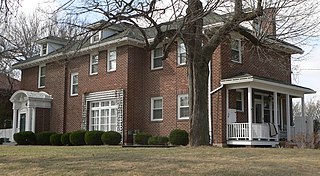
The Sanford House, also known as the Stone House and Summit Mansion, is a historic residence in Sioux City, Iowa. Throughout the 1990s, it was commonly referred to as the “Home Alone house” in reference to the similar looking neocolonial residence featured in the eponymous film that had become a pop culture phenomenon.

The Spirit Lake Massacre Log Cabin, also known as the Gardner Log Cabin, is located in Arnolds Park, Iowa, United States. Rowland Gardner had led a group of settlers into the region in 1856, and he built this cabin in July of that year. On March 8, 1857, a band of renegade Wahpekuta Sioux who had been alienated from the tribal structure attacked the Gardner family and other settlers in the immediate area in an incident known as the Spirit Lake Massacre. Led by Inkpaduta, the band of outlaws raided both Indians and white settlers for a period of about 30 years.

Beuttler & Arnold was an architectural firm in Sioux City, Iowa that designed several works that are listed on the National Register of Historic Places for their architecture.
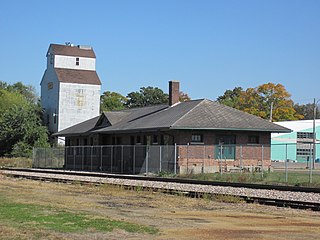
Illinois Central Combination Depot-Ackley is a historic building located in Ackley, Iowa, United States. The Dubuque & Sioux City Railroad, an affiliate of the Illinois Central Railroad (IC), laid the first rail track to Iowa Falls in 1865. Two years later the Iowa Falls & Sioux City Railroad, another IC affiliate, continued construction of the line to the west, and it reached Sioux City by 1870. They built a plain, two-story frame depot to serve Ackley. From the 1890s to the 1920s the IC replaced its first generation stations with new brick structures. IC architect J.H. Schott designed the new depot at Ackley, and it was built by Coomer & Small Construction Company of Sioux City. The long and low single-story brick building exhibits influences from the Prairie School and the Tudor Revival style. A combination depot is one that incorporates passenger and freight services in the same building. It was also an island depot, meaning that it sat in the middle of the tracks. It was one of the last replacement depots the IC built before the Great Depression. The building was listed on the National Register of Historic Places in 1990.

The Jim Baker Cabin was built in 1873 by frontiersman Jim Baker as a fortified house on the Little Snake River at Savery Creek near present-day Savery, Wyoming. The two-story log building measures 31 feet (9.4 m) by 16 feet (4.9 m) with two rooms on the lower level and a single smaller room on the upper level. The outer walls are made of logs 12 inches (30 cm) to 15 inches (38 cm) thick.

The Chicago, Milwaukee, St. Paul & Pacific Combination Depot-Hornick, also known as the Hornick Depot, is a historic building located in Hornick, Iowa, United States. The town was patted by the Chicago, Milwaukee, St. Paul & Pacific Railroad's land company when the railroad created a branch line from Manilla, Iowa to Sioux City. Completed in 1887, the railroad built this two-story frame structure to serve as its passenger and freight depot. It is one of six such depots that remain in Iowa, and the best preserved. These buildings were built from a standard design used by the railroad. The two-story stations included living quarters for the station manager because the towns had yet to develop when the depot was built. This was an island depot, with freight loaded on the north side and passengers boarded on the south. Decorative elements on this depot include lathe-turned wooden finials, angled wooden brackets, and bracketed door and window hoods. Passenger service ended in the 1950s, and grain was loaded here until 1980 when the Milwaukee Road abandoned the Sioux City branch line. The building was listed on the National Register of Historic Places in 1990. It has been converted into a local history museum.

The Julius and Anine Oversen House is a historic building located in Sioux City, Iowa, United States. In 1888 D.T. and Mary Hedges sold the property on which this house and surrounding neighborhood sits to the city for development. This was in a period of economic expansion that saw Sioux City grow to become the second largest city in Iowa. Julius Oversen worked as a brick mason. He worked on the Sergeant Floyd Monument (1901) in Sioux City. He may have served as contractor for this house, which he had built for his family from 1899 to 1900. This section of the city is called Morningside, and at the time this house was built, the street in front was called Live Oak Street. It was changed to South Lemon Street in 1911 when Sioux City adjusted the names on the streets and addresses in Morningside to correlate with the rest of the city. The two-story brick Italianate house features a wraparound porch, segmental-arched windows, bracketed eaves, and a low-pitched hip roof. In addition to the house, the historic designation of this property includes a two-story frame carriage house, a cistern, an inground planter in the front of the house, and two hitching posts near the street. They were all listed together on the National Register of Historic Places in 2007.

The Lewis System Armored Car and Detective Service Building, also known as the Bell Tire and Rubber Company and Sioux City Tent and Awning, is a historic building located in Sioux City, Iowa, United States. F.A. Martin and Richard Nash, who owned the property, had this two-story brick commercial building constructed in 1929. KB Construction, who built the building, occupied the second floor. Bell Tire and Rubber Company was the first business located on the first floor from 1930 to 1933. A few other businesses occupied the space until Sioux City Tent and Awning was located here from 1937 to 1941. The following year Lewis System moved in and remained until 1969. The second floor was converted into apartments about 1950.

The Motor Mart Building, also known as the Commerce Building, is a historic building located in Sioux City, Iowa, United States. It was built by Ralph A. Bennett, who was the owner of Bennett Auto Supply Company. The structure was designed in the style of the Chicago school by E.J. Henriques of the C.F. Lytle Company of Sioux City, who also built the structure. It was initially designed to be two stories tall, but the plans were changed and two more floors were added. It was designed to display, repair and provide parking for automobiles. It was also the first building in Sioux City to incorporate the flat slab system of framing of Claude A.P. Turner, and it was one of the first reinforced, poured concrete buildings in the city. The exterior of the concrete frame structure is clad with glazed brick over common brick infill. The building features terra cotta decorative elements.
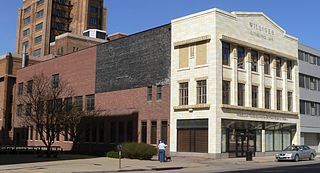
The Williges Building, also known as Cownie-Williges Building, is a historic building located in Sioux City, Iowa, United States. It is a three-story commercial block that was designed by local architects William L. Steele and George Hilgers. The structure was built for August Williges to house his fur manufacturing factory, salesroom, and storage facility. The decorative terra cotta details on the main facade are Sullivanesque in style, which reflects Steele's association with Louis Sullivan from 1897 to 1900. Completed in 1930, it is one of the last commercial buildings constructed in the early Prairie School style in the United States, and Steele's last architectural commission in Sioux City. It was also built at the end of the period of time when terra cotta was popularly used as wall cladding. The building was listed on the National Register of Historic Places in 2007.

The Sioux City Linseed Oil Works is a historic building located in Sioux City, Iowa, United States. It is located east of the central business district where warehouses and other industrial buildings are located. It housed the Sioux City Linseed Oil Works from 1884, when it was built, until 1927 when its owner, the American Linseed Oil Company, ceased production here. The building was largely destroyed in a fire that began late in the night of May 20, 1891. Mankato, Minnesota architect William D. McLaughlin stepped in to complete the work begun by Sioux City architect E.W. Loft. The building was rebuilt and was very similar in appearance to the original structure. The gable roof on the westernmost wing was replaced by a flat roof, and two floors were added to the rebuilt press room annex in the back. The building was acquired by Bekins Van and Storage Company in 1928. They began operations here two years later and remained the primary tenant in the building until 1972. There was a variety of other tenants who were housed here over the years. The building was listed on the National Register of Historic Places in 2008.
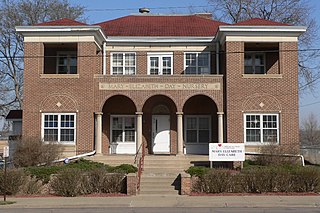
Mary Elizabeth Day Nursery, also known as Mary Elizabeth Day Care Center, is a historic building located in Sioux City, Iowa, United States. This is the oldest child day care facility in the state of Iowa, and the state's second-oldest preschool. The Sioux City Day Nursery was established in 1914 by the Wall Street Mission, a local settlement house operated by the Methodist Episcopal Church. They moved here in 1926, which is the first building designed as a day nursery in Iowa. The two-story brick Renaissance Revival building was designed by local architect Jurgen A. Raven, and built by The Lytle Company, a Sioux City construction firm. Parents were responsible for paying for at least part of their children's care, but it was also subsidized by religious institutions, private associations, and individuals. During the Great Depression, both the federal and state governments began to fund and license child care. The Works Progress Administration was involved in the 1930s. A garage and playhouse designed by Sioux City architect Knute E. Westerlind was built in 1940, and it is part of the historic designation. The facility was renamed the Mary Elizabeth Day Care Center in 1990. The building was listed on the National Register of Historic Places in 1997.

Albertson and Company-Rocklin Manufacturing Company is a historic building located in Sioux City, Iowa, United States. Completed in 1912, the building initially housed Automatic Valve Seating Mach Co. They reorganized in 1914 and became the Sioux City Machine and Tool Company, which produced spark plugs and tire valves. The company failed four months later and the shop foreman, Frans Oscar Albertson, formed Albertson & Co. and took over the plant. During World War I they supplied 6,000 piston rings and repair tools for munition plants for Canada. Albertson never owned the building and moved his operations to another Sioux City building in 1920. The company went on to become the largest manufacturer of portable electronic and air tools in the world. They changed their name to Sioux Tools Inc., and in 1993 they became a division of Snap-On Tools. Their manufacturing facility moved to North Carolina in 2001.




















